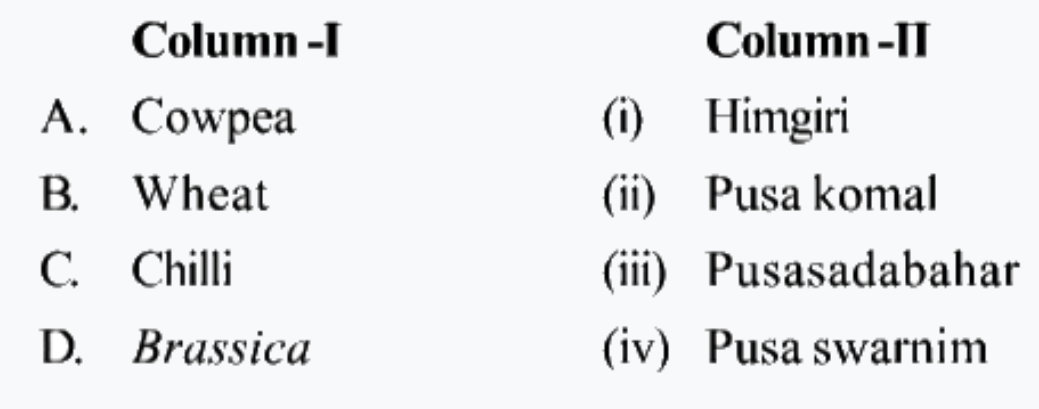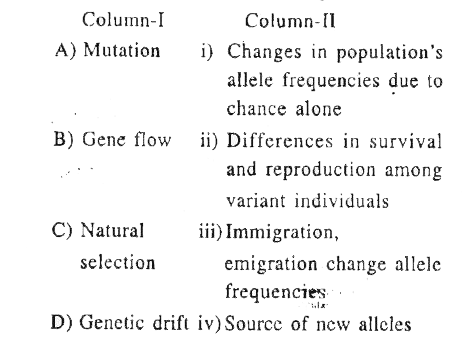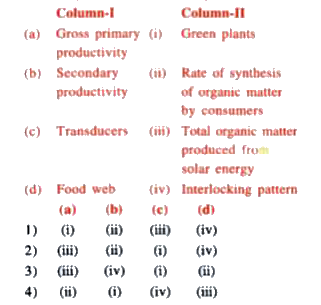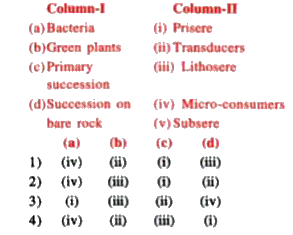Match column I with column II and select the correct option from the given codes
Column IColumn IIA. Hardwood(i). DuramenB. Soft wood(ii). AlburnumC. Heartwood(iii). Non-porous woodD. sapwood(iv). Porous wood
A-(iv),B-(iii),C-(ii),D-(i)
A-(iv),B-(iii),C-(i),D-(ii)
A-(iii),B-(iv),C-(i),D-(ii)
A-(iii),B-(iv),C-(ii),D-(i)
The correct Answer is:B
To solve the matching question, we need to identify the correct relationships between the items in Column I and Column II based on the characteristics of hardwood, softwood, heartwood, and sapwood.
1. Identify Hardwood:
- Hardwood is typically dense and tough. It is also known as Duramen, which is the inner part of the tree that becomes non-conductive due to the deposition of substances like tannins and resins.
- Match: A (Hardwood) → (i) Duramen.
2. Identify Softwood:
- Softwood is generally lighter and less dense than hardwood. It is also known as Alburnum, which is the outer part of the tree that is still active in conducting water and nutrients.
- Match: B (Softwood) → (ii) Alburnum.
3. Identify Heartwood:
- Heartwood is the central, non-conducting part of the tree that is formed from the older xylem. It is tough and dark due to the accumulation of substances.
- Match: C (Heartwood) → (iii) Non-porous wood.
4. Identify Sapwood:
- Sapwood is the outer layer of the xylem that is still active in water conduction. It is typically lighter and can be described as porous wood.
- Match: D (Sapwood) → (iv) Porous wood.
Final Matches:
- A → (i) Duramen
- B → (ii) Alburnum
- C → (iii) Non-porous wood
- D → (iv) Porous wood
Conclusion:
The correct option based on the matches is:
- A (Hardwood) → (i) Duramen
- B (Softwood) → (ii) Alburnum
- C (Heartwood) → (iii) Non-porous wood
- D (Sapwood) → (iv) Porous wood
- Hardwood is typically dense and tough. It is also known as Duramen, which is the inner part of the tree that becomes non-conductive due to the deposition of substances like tannins and resins.
- Match: A (Hardwood) → (i) Duramen.
- Softwood is generally lighter and less dense than hardwood. It is also known as Alburnum, which is the outer part of the tree that is still active in conducting water and nutrients.
- Match: B (Softwood) → (ii) Alburnum.
- Heartwood is the central, non-conducting part of the tree that is formed from the older xylem. It is tough and dark due to the accumulation of substances.
- Match: C (Heartwood) → (iii) Non-porous wood.
- Sapwood is the outer layer of the xylem that is still active in water conduction. It is typically lighter and can be described as porous wood.
- Match: D (Sapwood) → (iv) Porous wood.
- A → (i) Duramen
- B → (ii) Alburnum
- C → (iii) Non-porous wood
- D → (iv) Porous wood
The correct option based on the matches is:
- A (Hardwood) → (i) Duramen
- B (Softwood) → (ii) Alburnum
- C (Heartwood) → (iii) Non-porous wood
- D (Sapwood) → (iv) Porous wood
Topper's Solved these Questions
- BOOK - NCERT FINGERTPS ENGLISHCHAPTER - ANATOMY OF FLOWERING PLANTSEXERCISE - Assertion & Reason15videos
ANATOMY OF FLOWERING PLANTS
- BOOK - NCERT FINGERTPS ENGLISHCHAPTER - ANATOMY OF FLOWERING PLANTSEXERCISE - Anatomy Of Flowering Plants143videos
ANATOMY OF FLOWERING PLANTS
- BOOK - NCERT FINGERTPS ENGLISHCHAPTER - ANIMAL KINGDOMEXERCISE - Animal Kingdom148videos
ANIMAL KINGDOM
Similar Questions
Knowledge Check
- Question 1 - Select One
Match column I with II column II and select the correct option from the given codes .
 AA-(ii), B-(iii), C-(iv), D-(i)BA-(iii), B-(ii), C-(i), D-(iv)CA-(iii), B-(ii), C-(iv), D-(i)DA-(i), B-(ii), C-(iii), D-(iv)
AA-(ii), B-(iii), C-(iv), D-(i)BA-(iii), B-(ii), C-(i), D-(iv)CA-(iii), B-(ii), C-(iv), D-(i)DA-(i), B-(ii), C-(iii), D-(iv) - Question 2 - Select One
Mathc column I with column II and select the correct option from the given codes.
 AA-(ii), B-(iii), C-(iv), D-(i), E-(v)BA-(v), B-(iv), C-(iii), D-(i), E-(ii)CA-(i), B-(iii), C-(iv), D-(ii), E-(v)DA-(i), B-(iv), C-(iii), D-(ii), E-(v)
AA-(ii), B-(iii), C-(iv), D-(i), E-(v)BA-(v), B-(iv), C-(iii), D-(i), E-(ii)CA-(i), B-(iii), C-(iv), D-(ii), E-(v)DA-(i), B-(iv), C-(iii), D-(ii), E-(v) - Question 3 - Select One
Mathc column I with column II and select the correct option from the given codes.
 AA-(iii),B-(v), C-(iv),D-(ii)BA-(ii),B-(iv),C-(v),D-(i)CA-(ii),B-(iv),C-(v),D-(iii)DA-(iii), B-(v), C-(iv), D-(i)
AA-(iii),B-(v), C-(iv),D-(ii)BA-(ii),B-(iv),C-(v),D-(i)CA-(ii),B-(iv),C-(v),D-(iii)DA-(iii), B-(v), C-(iv), D-(i)
Match Column I with column II and select the correct option from the codes given below:
 View Solution
View SolutionMatch Column-I with Column-II and select the correct option from the codes given below.
 View Solution
View SolutionMatch Column-I with Column-II and select the correct option from the codes given below.
 View Solution
View SolutionMatch Column-I with Column-II and select the correct option from the codes given below.
 View Solution
View SolutionMatch column I and II and select the correct option from the given codes.
 View Solution
View Solution



